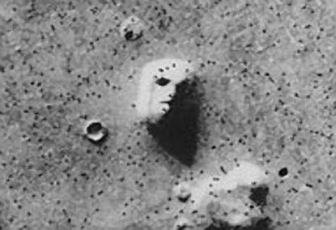To find life on Mars scientists will need to dig deep
To find life on Mars scientists will need to dig deep
American Geophysical Union
January 24, 2007
Probes seeking life on Mars must dig deeply
into young craters, gullies, or recently exposed ice to have a chance
of finding any living cells that were not annihilated by radiation,
researchers report in a new study. One promising place to look for
them is within the ice at Elysium, site of a recently discovered
frozen sea, they say.
Current probes designed to find life on Mars cannot drill deeply
enough to find living cells that may exist well below the surface,
according to the study. Although these drills may yet find signs that
life once existed on Mars, the researchers say, cellular life could
not survive incoming radiation within several meters [yards] of the
surface. This puts any living cells beyond the reach of today’s best
drills.
|
Original ‘Face on Mars’ image taken by NASA’s Viking 1 orbiter, in gray scale, on 25 July 1976. Mars face photo dashes hope for existence of Martians New images from the European Space Agency (ESA) show that the Red Planet’s famous “Face on Mars” is nothing but a eroded hill. The Face on Mars myth is based on a photo of Mars’ Cydonia region taken by NASA’s Viking probes in 1976. In the picture, the rock formation gives the appearance of a human face “formed by shadows giving the illusion of eyes, nose and mouth” as described in a NASA news release from July 31st, 1976. ESA’s new photos come after multiple attempts to image the Cydonia region between April 2004 and July 2006 were “frustrated by altitude and atmospheric dust and haze” according to the agency. |
The study, to be published 30 January in the journal Geophysical
Research Letters, maps cosmic radiation levels at various depths,
taking into account surface conditions in various areas of Mars.
The lead author, Lewis Dartnell of University College London,
said: “Finding hints that life once existed–proteins, DNA
fragments, or fossils–would be a major discovery in itself, but the
Holy Grail for astrobiologists is finding a living cell that we can
warm up, feed nutrients, and reawaken for studying.”
“Finding life on Mars depends on liquid water surfacing on Mars,”
Dartnell added, “but the last time liquid water was widespread on
Mars was billions of years ago. Even the hardiest cells we know of
could not possibly survive the cosmic radiation levels near the
surface of Mars for that long.”
Unlike Earth, Mars is not protected by a global magnetic field or
thick atmosphere, and for billions of years it has been open to
radiation from space. The researchers developed a radiation dose
model and quantified variations in solar and galactic radiation that
penetrates the thin Martian atmosphere down to the surface and
underground. They tested three surface soil scenarios and
calculated particle energies and radiation doses both on the surface
and at various depths underground, allowing them to estimate the
survival times of any cells.
The team found that the best places to look for living cells on Mars
would be within the ice at Elysium, because the frozen sea is
relatively recent–it is thought to have surfaced in the last five
million years–and so has been exposed to radiation for a relatively
short period of time. Even here, though, any surviving cells would
be out of the reach of current drills. Other ideal sites include young
craters, because the recently impacted surface has been exposed to
less radiation, and gullies recently discovered in the sides of
craters. Those channels may have flowed with water in the last five
years and brought cells to the surface from deep underground.
The study was funded by the United Kingdom’s Engineering and
Physical Sciences Research Council (EPSRC), the Swiss National
Science Foundation, and the Swiss State Secretariat for Education
and Research.
Citation:
Dartnell, L. R., L. Desorgher, J. M. Ward, and A. J. Coates (2007),
Modelling the surface and subsurface Martian radiation
environment: Implications for astrobiology, Geophys. Res. Lett.,
34, L02207, doi:10.1029/2006GL027494.














